




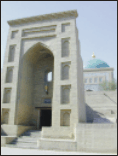

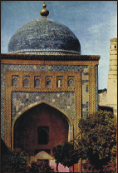









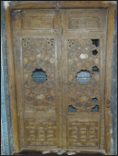
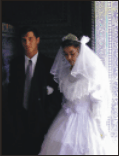
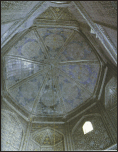
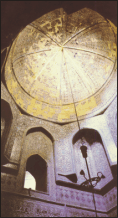




The entire interior is covered in blue and green majolica tiling with distinctive motifs complemented by rich gold borders. The remains of Mohammed Rakhim Khan I (1776-1826) lie directly in front of the door while the left-hand-side is reserved for the tombs of Abdul Gazi Khan (1603-1663) and Anusha Khan (died1681). A mullah sits in front of these graves inviting pilgrims to join him in prayer. After the 'Amin' (amen) has been invoked, the pilgrims leave money and food offerings before proceeding into a smaller chamber containing the tomb of Pakhlavan Mahmoud himself. The crypt can be seen through the portals of two elaborate wooden doors inlaid with ivory, coral and copper. Kneeling pilgrims touch these doors as they pray and then receive the blessing by washing cupped hands over their faces before returning the blessing and their hands to the doors once more.
Pakhlavan Mahmoud, the object of the pilgrims' devotion, was a fur hat maker and a famous poet. He was also a superb wrestler, winning every single of his wrestling matches as well as the hearts of the Khiva citizens who built a modest mausoleum for him on the site of his furrier workshop. This fast became a place of pilgrimage and a larger mausoleum was constructed where Khans such as Abdul Ghazi and Anusha chose to be entombed. However it was not until the ailing Mohammed Rakhim Khan began contemplating his departure from this life that the present building was constructed.
Mohammed Rakhim was far from popular, despite bringing much prosperity to the city at Bukhara's expense. His draconian measures against those caught drinking or smoking which involved the slitting of their mouths from ear to ear did little to endear himself to his subjects. In 1810 he began construction of this extravagant mausoleum supposedly in honour of Khiva's strongman, Pakhlavan Mahmoud, yet all the while planning that his own tomb would take pride of place beneath the emerald dome.
Mohammed Rakhim Khan was more successful in his burial plans than Isfandir, the last Khan of Khiva. Isfandir commissioned a mausoleum to the left of the main building with places for himself, his sister and his mother. (Khans were usually buried with their mothers rather than their wives, of whom there were far too many to be entombed together.) However his grave still lies empty after a fatal encounter with the Yomut Turkoman rebel, Junaid, in the Nurullabeg Palace in 1918. Because Isfandir Khan died outside the Ichan Kala walls he was not permitted to be buried within them and instead his remains lie in the Sayid Mugrumjan Mausoleum.
Tourists and praying pilgrims are not the only visitors to the mausoleum today. Pakhlavan Mahmoud is the patron saint of barren woman and so his grave is a stopping point for all wedding parties touring the old city. With friends and photographers, the bride and groom enter the mausoleum to receive a blessing and then head back to the courtyard for the all important drink from the strongman-s well. According to tradition, every woman drinking this holy water is guaranteed to have children. Men are not exempt from its benefits either - one glassful and the drinker will live for a hundred years, two glassfuls will ensure a life spanning two centuries but with three glasses the man-s greed will strike him dead on the spot.
Just opposite the magnificent aywan and former summer mosque stands an inconspicuous cell door which holds a fascinating secret. Inside a treasure trove is stashed away of rarely seen black and white photographs of Feruz Khan (Mohammed Rakhim Khan II), his sons and grandson, Temur Gazi. These include life-size, framed photographs of Feruz and his son, Isfandir. There are also photographs of Isfandir-s trip to St Petersburg and his portrait of the Tsar-s wife which bear evidence of the scandal which eventually led to Islam Hoja's assassination at the hands of Isfandir, his son-in-law. The room is not officially open to the public but the museum staff may be willing to unlock the door to individuals or very small groups in return for a small gift or the sale of some postcards. The photos and their stories can be found in 'The Last Khans' section of the Guidebook.



